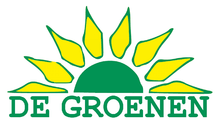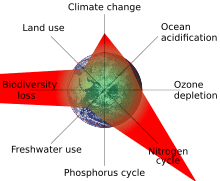The Greens (Netherlands)
The Greens | |
|---|---|
 | |
| Chairperson | Otto ter Haar |
| Founded | December 17, 1983 |
| Headquarters |
De Groenen Oudegracht 60 NL-3511 AS Utrecht |
| Ideology | Green politics |
| Political position | Centre-left |
| European affiliation | European Green Party |
| International affiliation | Global Greens |
| European Parliament group | The Greens–European Free Alliance |
| Colours | Green |
| Seats in the House of Representatives |
0 / 150 |
| Seats in the Senate |
0 / 75 |
| States-Provincial |
0 / 566 |
| Seats in the European Parliament |
0 / 26 |
| Website | |
|
www | |
| Part of a series on |
| Green politics |
|---|
.svg.png) |
|
Core topics |
|
Four Pillars |
|
![Azure, billetty Or a lion with a coronet Or armed and langued Gules holding in his dexter paw a sword Argent hilted Or and in the sinister paw seven arrows Argent pointed and bound together Or. [The seven arrows stand for the seven provinces of the Union of Utrecht.] The shield is crowned with the (Dutch) royal crown and supported by two lions Or armed and langued gules. They stand on a scroll Azure with the text (Or) "Je Maintiendrai" (French for "I will maintain".)](../I/m/State_coat_of_arms_of_the_Netherlands.svg.png) |
| This article is part of a series on the politics and government of the Netherlands |
|
|
Local government |
|
The Greens (De Groenen) is an ecologist party. It advocates an unconditional basic income and emphasizes its anti-militarism.
History
A group of Dutch environmentalists led by Marten Bierman founded the Greens on December 17, 1983. They entered the European elections under the name "European Greens" since the name "The Greens" was controlled by Bas de Gaay Fortman. The party's foundation was supported by the Francophone Belgian green party Ecolo, while the German Greens supported the Green Progressive Accord. The party became involved in the formation of the Coordination of European Green Parties. It won 1.3% of vote in the 1984 European parliament election below the threshold of 4% for a seat.
For the 1986 national elections the party used now the name "The Greens" which was abandoned. With Marten Bierman as top-candidate it won 0.2% of the votes, below the threshold of 0.7% for a seat. The party had a federal structure consisting of provincial parties. In 1987 the Greens participated in the North Holland, South Holland and Gelderland provincial elections. They won one seat on the States of North Holland, partially because of the support of Green Amsterdam led by Roel van Duijn. On March 10, 1989 Green Amsterdam merged with The Greens.
In 1989 GreenLeft was formed by PPR, PSP, CPN and the Christian left Evangelical People's Party. The Greens rejected to join this party because it emphasised social-economic issues too much and environmental issues too little. Independently, they participated in the 1989 elections with Roel van Duijn as their top candidate. The party won 0.35% of votes, below the threshold. The party abandoned its federal structure in 1992.
For the Dutch general election of 1994, GreenLeft proposed a candidate chosen by the Greens place 10 on their list, but this was rejected by the Green's Congress. The party entered the election with Hein Westerouen van Meeteren as top-candidate and won 0.2% of vote. In the 1994 municipal elections the party expanded its number of seats and won seats in Leiden, Nijmegen, Zwolle and Amsterdam. In 1991 GreenLeft MEP Herman Verbeek left his party and continued as an independent. He became a member of The Greens in 1994 and led their European list in the European Parliament election. The party won 2.36% of vote, below the threshold.
In 1995 the party contested several provincial elections. It won seats in North Holland and South Holland (on a combined GreenLeft/The Greens list). The party cooperated with several provincial parties to form a common list for the indirect elections for the Senate by the States-Provincial. The first seat was taken by the "Federation of Frisian Municipal-interest Parties" and the second by Marten Bierman. Bierman was elected by preference votes. He formed a separate Independent Senate Fraction, a novelty in Dutch politics. Before no group had previously had representation in the Senate without also being present in the House of Representatives. In the 1998 elections the party participated with Jaap Dirkmaat as top-candidate and won 0.2% of the votes. The party did keep its seats in municipal councils and expanded to Haarlem, Zeist, Arnhem, Groningen and Haren.
The Greens have not participated in the Dutch general elections since 1998. The Greens received 0.19% of the vote in the European elections of 2009 and 0.23% of the vote in the European elections of 2014.
House of Representatives
The Greens participated between 1986 and 1998 four times in the general elections. The head of lists were Marten Bierman (1986), Roel van Duijn (1989), Hein Westerouen van Meeteren (1994) and Jaap Dirkmaat (1998). The party failed to pass the threshold of 0,67 percent:
- Dutch general election, 1986: 18.641 votes (0,20 percent)
- Dutch general election, 1989: 31.312 votes (0,35 percent)
- Dutch general election, 1994: 13.902 votes (0,15 percent)
- Dutch general election, 1998: 16.585 votes (0,19 percent)
Since 1998 the party refrained from participating in the general elections.
European Parliament
The Greens is a founding party of the European Green Party.[1]
The Greens participated since 1984 four times in the European elections.
- European Parliament election, 1984: 67.413 votes (1,27 percent) the name of the list was European Greens
- European Parliament election, 1994: 97.206 votes (2,35 percent)
- European Parliament election, 2009: 8.517 votes (0,19 percent)
- European Parliament election, 2014: 10.883 votes (0,23 percent)
States-Provincial
The Greens have been elected in the States of North Holland between 1987 and 2003, South Holland (1995–1999) and Gelderland (1995–2003).
Senate
Between 1995 and 2003 The Greens were represented in the Senate by Marten Bierman. He was elected with support from provincial parties.
Municipal councils
The Greens have been elected in the municipal councils of Amsterdam, Leiden, Zwolle, Nijmegen, Haarlem and Haren.
Water boards
In March 2015 The Greens were elected to the water board of Amstel, Gooi en Vecht with 23,604 votes (5.9%).[2]
Comparison between The Greens and GreenLeft
- The Greens focus on introduction of an unconditional basic income[3] while GreenLeft puts conditions on benefits.
- The Greens wants the Dutch government to keep authority over the armed forces[4] while GreenLeft supports the goal of a European army.[5]
- The Greens are anti-militaristic compared to GreenLeft. The Greens sued the Dutch government in 2001 for taking part in operation Enduring Freedom,[6] while GreenLeft supported the presence of Dutch military in Afghanistan.
See also
References
- ↑ Green Parties | European Green Party
- ↑ election result AGV (Dutch)
- ↑ Platform The Greens, chapter 2 Basic income
- ↑ Platform The Greens, chapter 6 European Union
- ↑ GreenLeft about European defense
- ↑ Supreme Court of the Netherlands February 6, 2004, VJV, De Groenen e.a. vs. State of the Netherlands, ECLI:NL:HR:2004:AN8071
